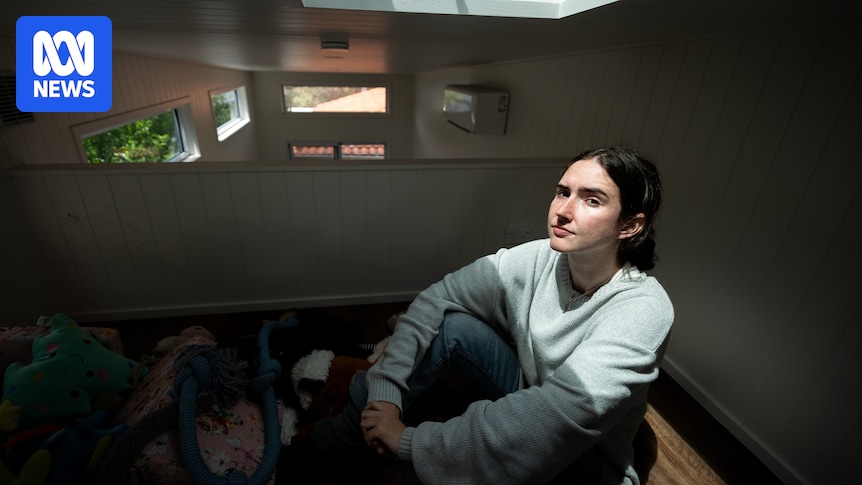A tiny home which began as a dream for Kathryn Payne, after she was diagnosed with epilepsy, has become little more than a $130,000 storage unit in her dad’s front yard.
The 30-year-old West Australian and her father purchased the tiny home in 2023 to help kickstart her independence, while also having her close to home so she could be supported medically.
“It’s felt absolutely horrendous to be having to deal with this, especially because I brought my dad into it,” Ms Payne said.
Ms Payne had hoped to progress her professional life but has been bogged down by her tiny home nightmare. (ABC News: Cason Ho)
Under WA law, people can camp in tiny homes on wheels on private property for up to two years with local council approval.
But the tiny home is in limbo after a neighbour complained to the council — the City of Wanneroo — which is now demanding the structure be removed from the property.
“I feel like my life has just been pulled right out from underneath me,” Ms Payne said.
Gerald Payne says the City of Wanneroo has provided little clarity about why the tiny home is not allowed. (ABC News: Cason Ho)
The City of Wanneroo is threatening to fine her father Gerald Payne $50,000 if the tiny home remains in his front yard.
“I can’t take a hit like that, and I don’t know what to do,” Mr Payne said.
“It’s been unbelievably stressful.”
Mr Payne, 67, took money from his superannuation to pay for his daughter’s tiny home, and to pay off most of his own mortgage.
He said they have tried to sell the tiny home following the local council’s disapproval, but sales have always fallen through after the situation was explained to prospective buyers.
Ms Payne’s tiny home on wheels has a shower and loft sleeping area. (ABC News: Cason Ho)
“We’re honest people, we don’t want to saddle someone else with this. We want them to know what they’re getting themselves into,” he said.
“They’re facing the same uncertainty with councils. This is the big thing … there’s no clarity, there’s no certainty.”
In a statement, the City of Wanneroo said it had provided “clear advice” on the requirements needed to ensure the structure meets safety and amenity standards.
“The City applies these laws consistently and fairly to maintain community safety and protect the rights of all residents,” it said.
‘Complication and confusion’
The Payne family’s experience is just one example of the broader issue sweeping through Australia.
Smaller tiny homes can be classified as caravans if they meet road regulations. (Supplied: Aussie Tiny Houses)
Griffith University urban management and planning emeritus professor Paul Burton said many councils were grappling with the definition and regulation of tiny homes.
“Across the country as a whole, it’s a picture of great variation, complication and confusion,” he said.
“Tiny homes won’t solve the housing crisis, but they’ll make a valuable contribution, so we shouldn’t ignore them.”
The Shire of Esperance in WA was the first council to implement a tiny home policy in 2023, recognising tiny houses as permanent dwellings, and other councils have since started creating their own policies.
But in many councils, people living in tiny homes are being served eviction notices and building orders.
Couple fights tiny house eviction
“My feeling is that at present, there isn’t enough political momentum to drive this forward,” Professor Burton said.
“I think the most we can hope for is that those councils, what they’re doing becomes well known, and people go, ‘if Esperance can do that and the sky hasn’t fallen in and it’s made a contribution, then why can’t we do it?'”
Uncertainty around state laws
In WA, a law change in 2024 allowed local councils to approve camping on private property, in caravans or tiny homes on wheels, for up to two years.
Tiny home advocates celebrated the change at the time, but Ms Payne’s case throws into question how much the law reform has achieved.
Ms Payne hopes she can still pursue her dream of tiny living. (ABC News: Cason Ho)
“We’ve just been going in circles … I wish my dad could retire. I wish I was the one supporting him at this stage, and I was hoping that’s where we would be,” Ms Payne said.
“I’m very lucky to be where I am right now and have had him continue to support me in this dream.”
In correspondence seen by the ABC, the City of Wanneroo said it defined the structure as an “ancillary dwelling” and not a “tiny home on wheels”.
Mr Payne says he has thrown everything at trying to keep his daughter’s tiny home. (ABC News: Cason Ho)
The city said it had approved the tiny home to be relocated to the backyard as a permanent structure.
But this would require significant investment to meet building standards, as the tiny home was designed to meet road regulations as a caravan and has a vehicle identification number.
“We’ve spent money on surveyors and engineers and it’s not progressed anywhere … I drew back on my mortgage to help with that,” Mr Payne said.
“I’m now in a situation where really, if I retire, it’s probably not affordable.”
Loading…Loading

